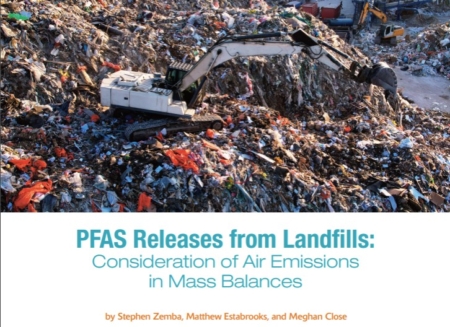Update regarding Per- and Polyfluoroalkyl Substances (PFAS)
The USEPA set forth an aggressive schedule for Per- and Polyfluoroalkyl Substances (PFAS) regulations in its October 2021 Roadmap, with major developments anticipated starting in Spring 2022. Thus far the major actions, such as hazardous substance designations, have yet to happen, but there have been some recent noteworthy activities.
USEPA May Actions – Risk-Based Regional Screening Level (RSL) Revisions – More PFAS, Lower Levels
On May 18, 2022, USEPA announced revisions to the Regional Screening Levels (RSLs) table that provides risk-based screening values for use at contaminated sites. Six PFAS were included in the revisions, and there have been substantial reductions in some of the tapwater RSLs as the USEPA is using more protective toxicity values.
| PFAS | Tapwater RSL (THQ=0.1) ng/L = ppt |
| PFBS | 300 |
| PFOA | 6 |
| PFOS | 4 |
| PFHxS | 39 |
| PFNA | 5.9 |
| HPFO-DA (GenX) | 6 |
For point of comparison, the original tapwater RSLs for PFOA and PFOS was established at 40 ng/L to be consistent with the USEPA 70 ng/L Lifetime Health Advisory – these RSLs have been reduced to 6 ng/L and 4 ng/L, respectively. Also note that the new RSL for GenX, a replacement and presently widely used PFAS, has been set at the same level as PFOA. Staff presentation materials to the USEPA Science Advisory Board indicate that toxicity values as much as 1,000 times more stringent are under contemplation, and also carcinogenicity designations. If the USEPA follows this even more protective approach, draft Maximum Contaminant Levels (MCLs) could be proposed at sub-ppt levels, and MCL Goals set to zero, which could lead to setting National Primary Drinking Water Standards at analytical limits of detection.
USEPA’s RSLs also include Soil Screening Levels (SSLs) for the six PFAS. SSLs for PFOA and PFOS at the THQ=0.1 criterion are set at 0.091 ng/g (ppb) and 0.0038 ppb, respectively. These criteria are far below background concentrations measured in soils in Vermont, Maine, and other locations. SSLs are criteria designed to protect groundwater from excess leaching from soil, and the impractical nature of the USEPA SSLs reflects the tremendous uncertainties in modeling PFAS fate and transport.
For more information and the revised RSL tables please refer to summary information on the USEPA website.
PFAS USEPA April Actions – NPDES Memo
The USEPA issued a technical memorandum on April 28, 2022 to update and manage PFAS under the NPDES program and to align the program with USEPA’s October 2021 PFAS Roadmap document. The memorandum issued by USEPA can be found here.
Highlights from the NPDES memorandum include:
- PFAS requirements will apply to publicly-owned treatment works, industrial discharges, and stormwater discharges
- USEPA plans to use the NPDES program to mitigate discharges of PFAS to water bodies, including requirements for monitoring of PFAS, best management practices to reduce or substitute PFAS use in processes, and developing approaches to address PFAS from fire-fighting foam in stormwater
- USEPA also intends to use the PFAS data collected as part of the NPDES program to inform development of Effluent Limitation Guidelines (ELGs) for PFAS
- USEPA is indicating that monitoring be conducting in accordance with USEPA Draft Method 1633 which includes a 40 compound analyte list
- Applicability is defined by the industries identified as PFAS containing in the PFAS Roadmap including: organic chemicals, plastics & synthetic fibers (OCPSF); metal finishing; electroplating; electric and electronic components; landfills; pulp, paper & paperboard; leather tanning & finishing; plastics molding & forming; textile mills; paint formulating, and airports
USEPA April Actions – Aquatic Life Criteria for PFOA and PFOS
In April 2022, USEPA issued draft national recommended freshwater Aquatic Life Criteria for PFOA and PFOS for a 30-day public comment period which ends on June 2, 2022. These criteria related to exposure to flora and fauna in freshwater environments and could be used in ecological risk assessments or evaluations of potential exposure to the environment from the two compounds. Here are the draft values:
- PFOA Acute: 49 mg/L (49,000 ug/L or 49,000,000 ng/L)
- PFOA Chronic: 0.094 mg/L (94 ug/L or 94,000 ng/L)
- PFOS Acute: 3.0 mg/L (3,000 ug/L or 3,000,000 ng/L)
- PFOS Chronic: 0.0084 mg/L (8.4 ug/L or 8,400 ng/L)
The proposed Aquatic Life Criteria indicate that, relative to concerns over PFAS in drinking water, threats to aquatic life are not substantial. Hence, when USEPA seeks to develop Ambient Water Quality Criteria, human health considerations will be the controlling factor, and drinking water standards are likely to serve as the ceiling of proposed values. Fact sheets and the draft documents for public comments on the aquatic life criteria can be accessed here for more information.
ME State Update
Maine DEP continues to implement its sludge and septage site evaluation statewide including starting land application site sampling in May 2022. Maine DEP also recently posted private well summary results by town as of April 22, 2022 which is located here. Maine DEP continues to sample private wells in areas located near former sludge/septage land application sites and other PFAS sources statewide. Maine DEP is also currently implementing requirements for sampling of PFAS at release sites statewide based on the June 2021 statute adding PFAS to the Maine hazardous substance list (see statute here).
MA State Update
The MA Inter-agency PFAS task force adopted their final report in April 2022 which can be accessed here.
Highlights of the report’s recommendations include:
- Fund PFAS detection and remediation: appropriate funds to MassDEP and DPH to test drinking water, groundwater, surface water, wastewater, residuals, soil, air, fish tissue, and other environmental media
- Support Environmental Justice Communities: provide more loan forgiveness for state programs for eligible projects in EJ communities
- Phase out PFAS compounds in consumer products by 2030
- Expand PFAS regulations including standards for additional compounds beyond the PFAS6 and include conditions for PFAS in groundwater and industrial wastewater discharge permits
NH State Update
New Hampshire is anticipating the need for treatment systems to remove PFAS from landfill leachate. A recent presentation by the New Hampshire DES indicates that over $9 million will be available over the next five years to assist municipally-owned landfills that currently discharge leachate to publicly-owned treatment works (POTWs). Pretreatment of leachate and other sources will be necessary to help POTWs meet effluent limits, which in turn will be demanded by surface water standards that per human health risk concerns are likely to be established at levels of drinking water standards or lower.
PA State Update
The PADEP is processing comments received on its proposed MCLs of 14 ppt for PFOA and 18 ppt for PFOS, which are notable given PA’s tendency to follow the USEPA’s lead on drinking water standards. It’s possible that these limits, which are stricter than the USEPA’s 70 ppt Health Advisory for PFOS and PFOA combined, are a harbinger of lower anticipated federal MCLs.
NJ State Update
The NJDEP has established an interim groundwater quality criterion of 2 ng/L (ppt) for chloroperfluoropolyether carboxylates (ClPFPECAs) with specific application to the Solvay site in West Deptford. Regulation of these non-targeted PFAS, which have likely been used by Solvay to replace legacy compounds, indicates a willingness on the part of NJDEP to develop standards at low levels for PFAS that have not received extensive study. As the interim criterion applies to total ClPFPECAs, detecting even one of these compounds will likely constitute an exceedance of the interim standard.
Risk Communication
Risk Communication is a key element of understanding and managing PFAS and other emerging contaminants. For an intriguing look at this topic, download a PDF of Steve Zemba’s presentation from his talk at the 2022 NEWMOA Brownfields Conference.
Posted In: Articles
Tagged In: Industrial, PFAS, Research






